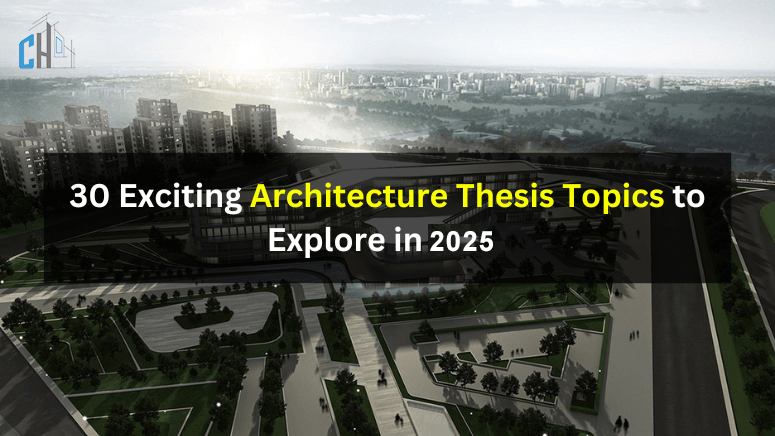Selecting the proper topic among an array of potential opportunities for an Architecture Thesis Project can be pretty overwhelming for a student. Compiled here is this extended list of possible directions that aim to motivate and help you in the selection of your novel and powerful project.
As diverse as they are, from sustainable urban design strategies to the development of new models in residential housing, each theme is evaluated based on their importance and relevance to today’s architectural trends.
A draft decision is your ticket to success and to the professional you’re seeking to spread your wings. It is for a specific kind of architect or designer you’d like. Please answer the following question.
I have compiled a list of 30 modern architecture thesis topics that will help you successfully defend your decision. However, choosing a topic is grave, and there are a couple of ways to make selecting your topic successful.
30 Updated Architecture Thesis Topics
Here are 30 diverse and contemporary architecture thesis topics, ranging from explorations of technology to socio-political considerations:
1. A Framework for Sustainable Growth
Confront the challenge of sustainable urban development by revisiting outdated structures such as ruined spaces and abandoned buildings as a foundation for new life and rebirth. By leaving the old structures, merging green spaces, and installing suitable green technologies, cities can be dynamic, eco-friendly centers that concentrate on environment conservation and community health.
2. The Role of Architecture in Fostering Community Resilience Against Natural Disasters
Discuss the measures by which architecture is a sign of a solution and even a tool for comfort with the increasing rate and severity of natural disasters. Considering the function of architecture to thwart devastations and provide comfort to the affected more is a dimension that has to be looked at closely.
3. Augmented Reality and its Implications for Architectural Interaction and Experience
Confront the magical world of augmented reality technologies and their transcending power to create new dimensions of architecture or architecture that defy the laws of nature and influence human interaction within the built environment. Let’s leap into the enthralling intersection where, when the latest AR rhymes with design art, you can savor an immersion that is more than the conventional space rules!
4. The Integration of Biophilic Design in Urban Settings: Mindfulness and Well-being in the City
Study the implications of reintroducing wilderness into urban areas and create design guidelines relevant to elevating typically grounded people’s mental health.
Discuss the ways of including green spaces, natural things, and biophilic design principles in planning the built environment to create a better or more comfortable quality of life for people and enhance psychological health.
5. Housing Design for Sub-Saharan Africa
Give an idea of the possible housing types that are sensitive to the atmospheric and material ad hoc as well as the cities’ separate needs throughout Sub-Saharan Africa.
This integration on the cutting edge of design could help create homes that unite traditional building knowledge with contemporary design solutions, leading to the creation of culturally sensitive, green, and, at the same time, economically sustainable houses.
We can together contribute to better cope for housing solutions for Sub-Saharan Africa that are sustainable and supplement the local context.
6. Modern City in the Wake of the Pandemic
Contemplate the means through which the pandemic may have touched up the value of public space and density and seen in them in urban areas.
7. Architectural Activism: Design as a Catalyst for Social and Environmental Change
It is!! Identify examples where architects engaged in politics following architecture principles to stimulate change and equality.
8. The Spatial Politics of Gentrification and Displacement in Major Metropolises
Join us as we thread through the intricate geographical implications of gentrification, following in the evolving and changing urban scenes. Propose innovative and practical designs that uniquely blend both aspects of economic development and social equitability for everyone in the community.
9. The Psychological Impact of Architectural Structure and Space
Study the intriguing topic of the psychical effect created in the occupants’ minds and behaviors by different architectural styles and designs. Explore how the appearance of architectural components can turn these places into social spaces that craft human behavior patterns.
10. Designing for Disaster: Architectural Preparations for Global Warming and Rising Sea Levels
The design should be resilient to the architectural manipulations required to face the challenges of impending climate change now.
11. Vertical Urbanism in Developing Countries
By virtue of onward urbanization, one must perform research on the latest and most efficient urban architectural methods that could overcome the municipal challenges that developing cities encounter when it comes to their rapid expansion.
This category encompasses solutions aiming at maximizing space utilization and functioning as a stimulus for sustainable urban development under a growing population and land shortages.
12. Responsive Architecture: Buildings That Interact and Adapt to the Surrounding Environment
Create a range of dynamic architectural models that intelligently and in real-time adjust to the variable interaction of the environment aspects, including natural lighting, temperature, and background noise.
These sampling prototypes aspire to improve user experience and a sustainable environment through the use of steadfast features that work in harmony with their surroundings.
13. The Revitalization of Industrial Heritage Sites in the New Millennium
Create an extraordinary revival through rebranding the old industrial facilities, which not only gives recognition to the history of those sites but also supports the work of urban rehabilitation and promotes a creative culture within the community. Through appropriate reutilization of these locations, while preserving their historical value, we can invigorate hitherto forgotten niche spots and lay the foundations of chances for young people to come.
14. Virtual Communities, Physical Spaces: Reconciling the World of Social Media with Architecture
might have been fundamentally different at their core, clashing could result from social media clashes.
Devise novel architectural solutions to fortify a fully functional virtual and physical space while preserving our identity. Learning from computer interaction models that depict various types creates a design of structures that reflect and intensify the connections and relationships that occur in the digital world.
15. Sustainable Campus Design for the 21st Century University
Rethink the campus model to embody our green ambassador, realizing the congruence of green technology and eco-friendly beauty.
This creative design hopes to be the place for that set of environments that are both functional and helpful to the learning and growth of the students and give them an opportunity to be shaped on environmental awareness and responsibility.
16. The Resilient Suburb: Adapting Urban Design to the 21st Century
Reconsider the neighborhoods of the suburbs by embedding various innovative infrastructure design patterns and practical strategies that address the strenuous socio-economic, demographic, and environmental conditions in the future.
17. Architectural Narratives and Storytelling: Communicating Culture through Design
Give the cultural heritage of our metropolitans a unique and charming touch with creatively designed space that is enriched with art equaling to storytelling, and you will have a product that has numerous narratives and the voices of many whose story is being woven into the present and future. The built environment includes the past, present, and future of all people and communities.
18. Architectural Narratives and Storytelling: Communicating Culture through Design
Lend spaces within the dwellings have the ability to encourage closer connection among the community with the intention of establishing a sense of belonging.
19. The Aesthetics of Surveillance: Balancing Security with Privacy in Public Spaces
Form designs of surveillance that are in line with expectations of freedom grants and privacy by the public.
20. An Architecture for Peace: Creating Spaces that Facilitate Diplomacy and Conflict Resolution
Come up with new architectural models that not only facilitate novel diplomatic processes but also function as practical tools in maintaining calm or peace by avoiding conflicts or resolving them. Through the creation of such spaces, which favor dialogue, understanding, and cooperation, architects have the ability to reach global ties and help make the world a better place.
21. Integrating Diverse Mobility Solutions in Urban Planning and Design
The generation of eco-friendly cities, therefore, needs the blending of diverse ways of mobility comprising walking, cycling, public transport, and private vehicles. Such means of transportation can be integrated into mainstream methods; thus, doing so would give people a chance to select what suits them in a way that they would rather travel from one place of work to the other for better efficiency and fairness.
This multilayered consequence not only enhances intracity mobility but also social integration and environmental sustainability in cities.
22. Housing the Next Billion: Innovative Housing Models for the Urban Poor
Invent the micro-dwelling models that incorporate the present day’s infrastructural facilities to introduce a sophisticated communal living style that will elevate the standards of living in the marginalized urban population.
These initiatives address the problem of limited available space and insufficient resources by relying on space efficiency, environmentally friendly materials, and facilities that promote community, thus improving the standard of living for the homeless.
23. The Invisible Architecture of Sound and Acoustics
Research the details behind intricate and largely overlooked audio designs that may seem to be negligible but, in fact, are responsible for creating our soundscape. Broach the idea of sound as a tool of spatial perception that can show us the beauty that people can miss, which is like harmony between architecture and the auditory sensations.
24. Transient Cities and Peripatetic Architecture
Imagine architectures’ modeling of natural efån-fortress attune themselves to humans’ transient lifestyles, especially those who are into the digital nomadic life. Such models are innovative ones that should combine with spaces that are flexible, multifunctional elements, and sustainable in nature to serve the interests of people traveling dynamically and mobile in the future.
25. Postindustrial Food Systems Architecture
Develop unique production facilities that are targeted to fit into the flexible framework of newer practices of food production, distribution, and intake pace of the postindustrial economy.
Sustainable, reliable, and efficient food production from farm to table requires the application of integrated green practices, the latest technologies, and intelligent processes in food facilities. The food gets to the table in an ecologically desirable as well as economically feasible way.
26. The Architectural Implications of Artificial Intelligence and Machine Learning
Conjecturing significant AI incorporation consequences in the field of building, highlighting its role in transforming the previously existing processes, making structures more sustainable, programming energy management, and introducing self-controlling and adaptable buildings of the future.
27. Sites of Memory and Spaces of Healing
The design and specific purpose of the architectural sites in commemoration of traumatic moments in time or the lingering pain they represent should be instructed to contribute to the process of healing on both individual and societal levels.
28. The Architectural Language of Intangible Heritage
Being a vital source for the construction of images, the most important means of communication and the foundation for social cohesion and therefore it should be communicated with the intellectuality characteristic of the modern language.
Convert the intangible elements of heritage language, rituals, and social practices) into tangible and perpetual architectural structures that are able to represent these elements.
29. Resilient Design of Public Housing Estates in Extreme Climates
Empower public housing by making it climate-proof, accomplish it through efficient systems, and use climate-smart building materials that ensure the sustainability of the environment.
Additionally, it emphasizes creating community resiliency by providing familiar places and other spaces that will help to address social interaction and favor the development of neighborhood support groups.
30. The Automation of Building Construction: Redefining the Role of the Architect
Set up the phase of a prospective outlook onto possible ways architecture could counter-react to the surge of automation. Reflect on the complexity of this paradigm shift, considering the difficulties and possibilities that this may imply, thereby building a new design domain.
Tips for Selecting the Right Topic
While the list above presents a diverse range of thought-provoking areas for exploration, let’s delve deeper into some guiding principles to help you pinpoint the perfect thesis topic that aligns with your interests and goals:
Consider Personal Interests
Your thesis is probably the most essential part of your statement, and it indicates your knowledge of your background, areas of strength, and future goals. Select a topic that may intrigue you and fit within your long-term career ambitions.
Research Opportunities
The excellent topic is earning a balance here so that it widens up to be reasonable to do the research and narrow to be explored within the thesis paper.
Seek Mentor Guidance
Talk to your departmental counselors and select an advisor and supervisor. They will not only guide you but also have an essential contribution in helping you narrow down your interests into a theoretical research statement.
Conclusion
Choosing your thesis architecture topic is both the first significant challenge and the basis of the overall process, being challenging and exciting at the same time.
Make sure you put thorough consideration before making your decision; this is the opportunity to project your individual self. When in doubt, remember that the best topic is not something that you’re just not interested in, it is something that has the potential to change the world of architecture positively. Make a choice, and go and defend your thesis statement in a lively and artistic manner.
Following some common architecture thesis topics, one should keep in mind that you should not be limited only to the above catalog. Your architecture thesis is your very own creation, and you are not under any obligation to be a part of any category, neither to conform nor to fit.
Another outstanding architecture thesis also acts as a push to the final creation of a kick-ass architecture portfolio! So give your all. You might even get one for your architecture thesis one day.
I do hope you found what you were in search of.



